History of Rice
Please click on the links below to find information on the Early History of Rice:
- The Prehistory or Rice
- Current debates around the origins of rice
- Anatomy of the Rice Plant (Wild, Immature and Domestic)
- Phytoliths
- Diatoms
The image below illustrates the spectrum from drier to wetter rice cultivation systems.
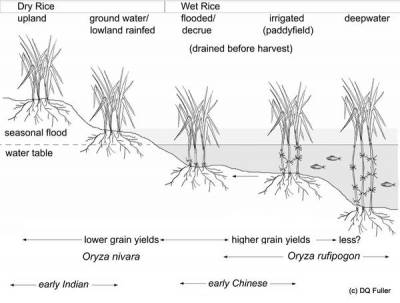
- Dry to Rain-fed - water levels fluctuates according to season and growing period. can be subdivided into upland and lowland rainfed rice. About 13% of rice is upland type.
- Decrue agriculture, of flooded rice is grown in the shallow water of wet season flooding. The practice is especially prominent in West African rice production on the Niger River but similar systems are found in Asia and were probably once more widespread.
- Irrigated - fully controlled floodwater is kept shallow. This is what we asscociate with typical "paddy" fields. Some rice grown at higher elevations well-maintained terraces can be classed as this type.
- Deepwater - floodwater can rise to more than 50cm (even up to several metres)
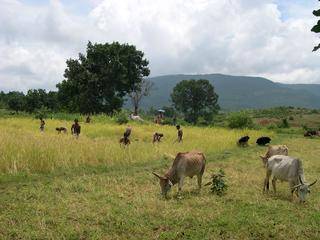 | 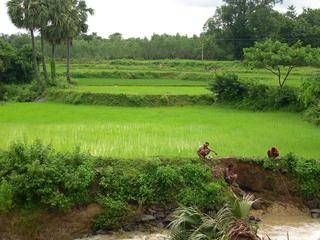 |
| Upland Dry Framing in Orissa | Wet Rice (irrigated0 Framing in Orissa |
Why Flood a Rice Plant?:
- Increases soil fertility
- Stabalizes soil moisture and temperature
- Prevents soil erosion
- Depresses soil-borne disease and weed growth
How does flooding produce Methane?
Flooding cuts off oxygen supply to the soil which causes anaerobic fermentation of which methane and carbon dioxide are major end products
- What is anaerobic fermentation?
- What is methane?
Methane is released through diffusion and ebullition through the stems and roots of rice plants
- What is diffusion and ebullition (gas bubbles)
- Rice has developed aerenchyma tissue which allows methane to escape the soil through the plant structure. This is a hollow series of tube-like structures within the plant that transport air bubbles through the rice plant.
- Methane that does not escape during flooding is stored in the soil and released when the water is drained away
- Methane production is increased with higher soil temperatures (tropical sites), higher carbon content, and with higher grow rates such as during the cropping season
The Methane Record:
- One of the most common greenhouse gasses, Methane (CH4) is 20 times more powerful that CO2 at warming the atmosphere by weight, and thus one of the most prolific contributors to global warming and climate change. (Xiong et al 2008)
Methane production is increased by certain cultural farming practices such as:
- Wet tillage
- Puddling
- Harrowing
- Weeding
- Harvest
- It is therefore important to look at social practices before relying on the methane level to reconstruct rice agriculture in prehistory. The analysis of modern analogue systems allows us to apply these techniques to the archaeological record in a comparative manner.
- In our first attempt to translate archaeological evidence for rice into a model of land area under wet rice that produced methane in the past, we found the the rice in wet rice area between 3000 BC and 1000 AD paralleled the increase in methane recorded from the greenland ice core (Grip 2). However, in the earlier stages of this period it may be that the amount of wet rice production was not enough to account for the methane anomaly and other factors like the spread of domesticated animals must be considered. For details see our publication in The Holocene [pdf]
Diagnostic Indicators for reconstructing rice ecology:
Diatoms:
- Most commonly microscopic one celled algae organisms encased in a silica shell which allows them to be preserved in the archaeological record usually layered within seabeds or other strata to form part of the record for geological activity and environment in prehistory.
- Diatoms are present in any water bearing environment, in particular soil, and can show the environmental behaviour of
- Microscopic silica body within a plant's structure that archaeologists can use to reconstruct plant profiles. The inorganic remains survive in the archaeological record and are diagnostic to plants, and parts of plants.
- Phytoliths are prepared from plant remains that have been charred to leave the phytolith isolated for analysis. This can also be done through chemically dissolving the surrounding soil, or by bleaching.
Seeds:
- Seeds will inform archaeologists about what plants were present at a site and in what quantity. This is a comparative analysis that will demonstrate the prevalence of rice at archaeological sites, and what weeds were present.
Assemblages:
- An assemblage is the larger context of the archaeological record. Diatoms, phytoliths and seeds are the micro-remains which are individual components which make up the larger site, such as a padi field or terrace, which is known in the archaeological record as an 'assemblage'.
The Early Rice Project is looking at assemblages in three ways:
- Creating a record of assemblages from modern day traditional rice farming in Asia
- Analysing micro-remains from prehistoric rice assemblages
- Comparing the two records to reconstruct a model of rice agriculture
- Indica vs. Japonica - these two variations of the rice plant were domesticated through distinct events.
Cultivation vs. Domestication (after Fuller, Harvey and Qin 2006) - the first implies human activity, and the second changes in the plant structure. The overlap of the two lasted between 1-2 millennia, and can be measured against diagnostic morphological changes from wild to domesticated rice such as:
- Decrease in hairs designed to help the rice spikelet grip soil. This was to help rice plants naturally disperse, which was made redundant with humans doing this for it.
- Increase in grain size and weight (this can be seen through the phytolithic record)
- Non shattering spikelet base so that plants could be harvested without damage. In addition, this meant that rice plants maintained all grains at maturity rather than scattering.
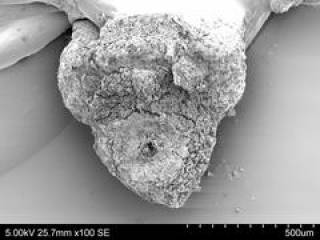 | 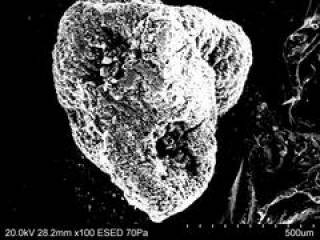 |
| Wild rice spikelet base (left) | Domesticated rice spikelet base (right) |
 Close
Close
